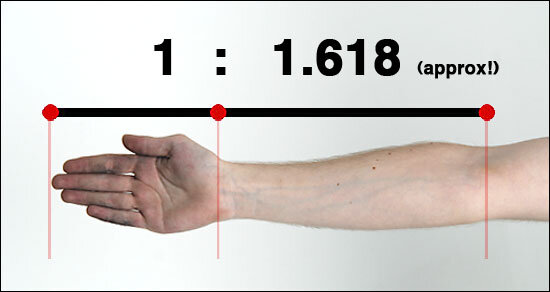“Your compositions seem…comfortable,” said a recent studio visitor. He went on, wondering out loud, “I’m not sure what I even mean. They have nice proportions”. Little did this gentleman know, but he just wandered into one of the subjects I truly geek out over: the Golden Section. Look it up. You’ll probably geek out too. It’s the secret to perfect proportions.
This is not just some ancient and obscure math formula. It is literally the language by which the universe was designed.
As a kid, I hated math. It was dry, dead and boring. But as I grew up, I came to realize that math was handy. You can balance a checkbook (if you really need to) with math. I had no idea that math could actually be elegant and beautiful. With math, you can construct perfection. With math, you can design using the the Golden Section (also called the Golden Mean and Divine Proportion). What is the Golden Section? Imagine a line (C) that is cut into two sections: a longer section (A) and a shorter section (B). When the ratio of the whole line (C) to the longer segment (A) is equal to the ratio of the longer segment (A) to the shorter segment (B), THAT ratio is the golden section. It is the ratio: 62:38 or 1:1.618.
This is not just some ancient and obscure math formula. It is literally the language by which the universe was designed. That’s a really big deal. Let me illustrate.
If you take the average height of a human and divided it into two (using the golden section), you locate the navel.
If you take the average distance from your shoulder to you fingertips and divide your arm into two sections (using the golden section), you locate your elbow. Divide the distance between your elbow and your fingertips (using the golden section) and you locate your wrist. Keep dividing and you locate each knuckle all the way to the end.
If you take the length of a dolphin, and divide it into two (using the golden section), you locate the dorsal fin.
The Golden Section was used to design the footprint for the pyramid complex of Giza as well as the actual shape of the pyramids. See, if you draw a ling straight down from the tip of the pyramid to the ground, and then from that point to the outside edge of the pyramid, THAT is the golden section. This ratio was used in the design of the parthenon and the Arc of the Covenant in the Bible, and innumerable cathedrals constructed over the centuries.
This ratio is even found in nature. If you take the distance from the sun to the orbit of Venus, and divide that distance in two (using the golden section), you locate the orbit of Mercury. If you take the distance from the sun to Earth and divide that distance in two (using the golden section), you locate the orbit of Venus. This works clear out to the orbit of Venus. You can even see the Golden Section in the spacing of the rings of Saturn.
So what? Well, for some reason, that proportion is the “gold standard” of pleasing proportions. The closer to that proportion you get, the happier your eye will be. And so, knowing that, find a painting or photo you really like. It could be depicting nature or architecture. If that photo is “pleasing to look at”, chances are, the Golden Section is all over it like an invisible scaffolding holding up the visible artwork (or edifice).
Because of all this, I am regularly using math to plan my compositions. Take the height of my painting, say 24”. To locate the horizon, I’ll calculate 38% of that total distance, and draw the horizon line 9-1/8” up from the bottom. To locate the tall tree I want as the focal point of the painting, I’ll draw a line over from the edge that is 38% of the overall width of the canvas. Using this ratio as a guide, I’m sure to design a painting that will eventually be proportioned as close to perfection as I can get it. The rest is just slapping some paint in the right places and voila, a perfect painting! Easy, right?






